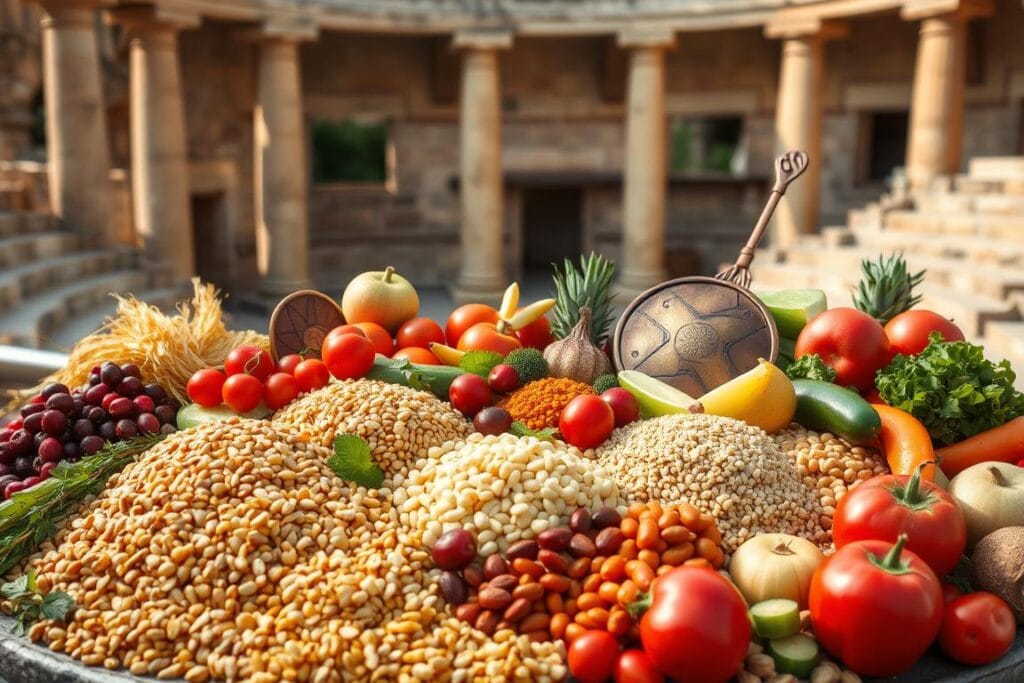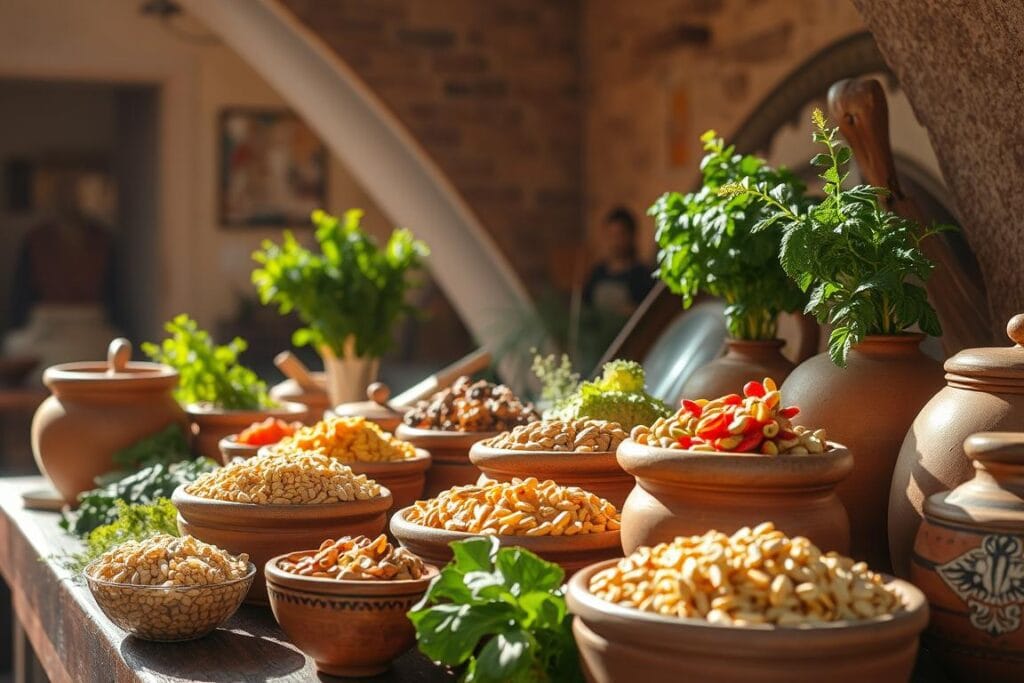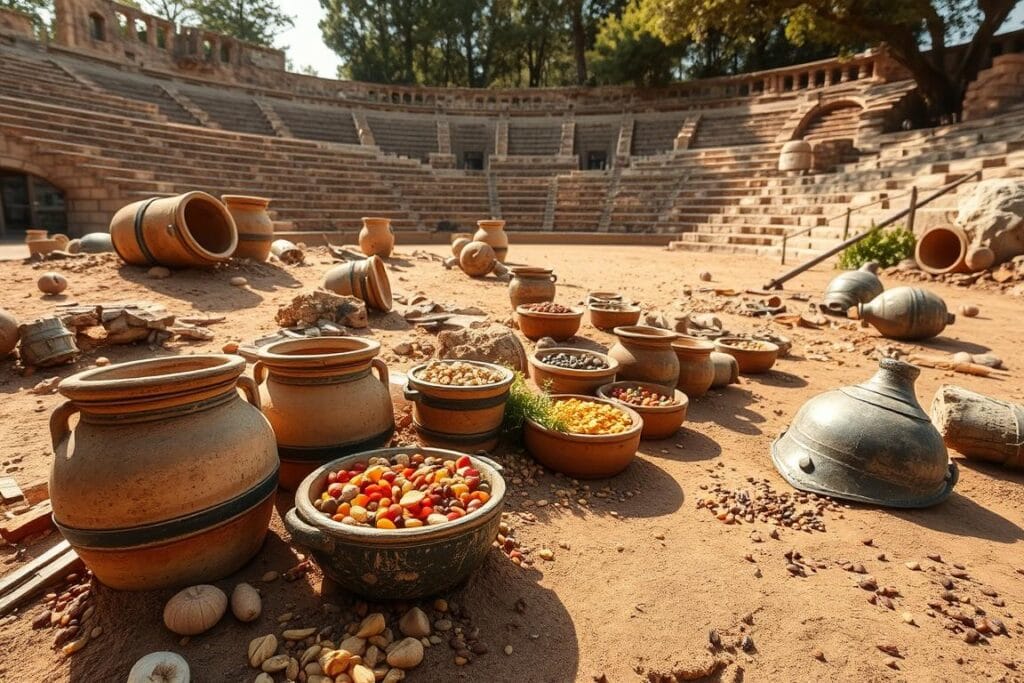
Ever thought about how ancient Roman gladiators’ diet could link to today’s veganism? Their diet was mostly plants, not just meat. This challenges the idea that only animal protein builds strength. New research shows their eating habits might still guide us towards better health today, highlighting the connection between the Gladiators Diet and Veganism.
Introduction to Gladiator Diets in Ancient Rome
https://www.youtube.com/watch?v=PLzWGQLzu4A
Gladiators were more than fighters in ancient Rome’s arenas. They were athletes who needed a special diet to perform well. Their diet was mostly vegetarian, focusing on muscle growth and recovery.
They ate a lot of barley, beans, and grains. These foods gave them the energy they needed for battles. This diet was key to their success in the arena.
Studies of their bones show they ate very little animal protein. They mostly ate carbs from legumes. This choice helped them build fat for protection during fights.
Some gladiators were slaves or convicts, but others chose this life for fame and fortune. They knew how important diet was. Over 100 gladiator schools across the Roman Empire trained athletes with specific diets.
Gladiators got good medical care and supplements. They got calcium to keep their bones strong. Their bones had more calcium than others, showing the value of their diet.
This shows how important diet was for gladiators. It helped them be strong and perform well. Their diet was a key part of their training and success.
Historical Evidence of Gladiator Dietary Practices

Looking into the diet of gladiators gives us interesting insights. Ancient historian Pliny the Elder called them hordearii, or barley-eaters. This shows how important barley was in their meals. Barley was a key source of carbs, giving them the energy they needed for battles.
Gladiators ate a lot of plant-based foods, like barley and legumes. Their bones had more strontium than modern Ephesians. This shows how good their diet was for them.
Roman legionnaires ate mostly carbs, from wheat and barley. The Institute of Medicine says athletes need 0.8 grams of protein per kilogram of body weight daily. Studies show vegetarians and non-vegetarians perform equally well in sports.
In Ephesus, gladiators ate a lot of carbs and sometimes took calcium supplements. They ate more plants than average Ephesians but less animal protein. They chose simple carbs like barley and legumes for energy. Calcium from charred wood or bone ash was also part of their diet.
Archaeological Findings Supporting the Gladiators’ Diet

Recent digs have uncovered the eating habits of gladiators, especially in Ephesus. A study looked at 53 people, 22 of whom were gladiators. It used a method called stable light isotope ratio analysis to see what they ate.
The results showed gladiators mainly ate whole foods like barley and legumes. This shows they followed an ancient diet rich in plants. It’s a diet that’s good for health.
Isotope analysis found unique values in some bones. This suggests gladiators might have moved around or eaten different foods. Their δ15N values were low, showing they ate a lot of legumes.
This is different from other Romans, who might have eaten more meat. It shows gladiators had a special diet.
Their bones also had high strontium to calcium ratios. This means they got a lot of calcium from plants. Galen, a famous doctor, said gladiators ate bean pudding and barley.
This supports the idea that their diet was mostly vegetarian. The study also found strontium in their bones, which is linked to plant-based diets. It shows gladiators ate carbs to fuel their training and drank an “ash drink” to stay healthy.
Analysis of Plant-Based Diets in Gladiator Culture
Exploring plant-based diets in gladiator culture offers insights into their nutrition and culture. Gladiators mainly ate grains like barley and legumes. Foods like beans and lentils were key to their meals. This diet choice showed their strength and endurance.
Gladiators also ate animal products like meat, fish, and dairy. This mix in their diet is important to note. Their bones showed lower nitrogen levels than average Romans, meaning they didn’t always eat plants. Archaeological finds from places like Thebes show they ate fish too, adding variety to their diet.
Their diet was a mix of sustainable eating and cultural importance. In schools like Carnuntum and Pompeii, they learned about nutrition. This knowledge helped them perform better in the arena, possibly gaining access to richer foods.
Here’s a quick look at what gladiators ate and why:
| Dietary Components | Description |
|---|---|
| Grains | Mainly barley and millet, providing essential carbohydrates. |
| Legumes | Beans and lentils contributed protein and fiber. |
| Animal Products | Occasional intake of meat, fish, and dairy led to a mixed diet. |
| Nutritional Strategy | Focus on plant-based foods for energy and endurance; animal products rewarded for performance. |
| Cultural Significance | Plant-based diets symbolized strength, adherence to sustainable eating practices. |
The diets of gladiators show more than just what they ate. They reflect their cultural values and societal expectations. Today, we can learn from how ancient practices shape our eating habits.
Gladiators Diet and Veganism: A Comparative Perspective
Looking into the Gladiators Diet and Veganism gives us interesting views on veganism today. Their mostly plant-based diet helped them stay strong and active. It also matches what we know now about healthy eating and staying fit.
Understanding Nutritional Choices in Ancient Rome
In Ancient Rome, people ate a lot of grains, fruits, veggies, and beans. Gladiators, known as “barley men,” mainly ate carbs from barley and legumes. This shows how ancient diets are similar to veganism today, highlighting their health benefits.
They also ate whole foods, not processed ones. This is what health experts recommend today.
Similarities in Dietary Patterns
Gladiators Diet and Veganism: Gladiators and today’s athletes share similar diets. Modern athletes and elite runners prefer high-starch plant foods, just like gladiators. Studies show that vegetarian athletes often have better heart health.
This supports the idea that plant-based diets are good for performance, both then and now.
Health Implications of a Plant-Based Diet for Gladiators
Gladiators Diet and Veganism: The diet of gladiators offers insights into the health benefits of a plant-based diet. They mainly ate grains, legumes, and pulses. These foods gave them the energy they needed for their tough lifestyle.
This diet choice helped them perform better in the arena. It shows how eating plant foods can be beneficial.
Enhancing Performance through Nutrition
Plant-based nutrition is good for athletes, and gladiators were no different. They ate a lot of carbs for energy. Legumes gave them protein for muscle repair after training.
Fruits and vegetables gave them vitamins and minerals. This made their diet very healthy. It’s a strong argument for eating more plant-based foods.
Today, athletes see big improvements by switching to a plant-based diet. The film “The Game Changers” shows famous people like James Cameron and Arnold Schwarzenegger. They talk about how this diet helped them achieve great things, including setting world records.
This diet not only meets protein needs but also has antioxidants and anti-inflammatory properties. These benefits help athletes stay healthy and perform better.
Plant-based eating can benefit both male and female athletes. Female athletes need to watch out for iron and calcium. But the health and performance benefits of plant-based diets are clear.
The ancient diet of gladiators matches today’s research. It shows that plant-based nutrition is still key for better athletic performance.
Conclusion
The study of gladiators’ diets shows us how ancient nutrition still matters today, especially for vegans. Archaeologists found that gladiators ate mostly plants, like grains. This diet helped them stay strong and healthy.
This knowledge is great for vegan athletes today. It shows how eating mostly plants can help them perform well. Gladiators sometimes ate meat, but mostly they ate plants. This made them strong and agile.
Gladiators had high levels of minerals in their bones. This suggests their diet was balanced and full of variety. This idea supports the idea that eating plants is good for health and performance.
Thinking about your diet? Remember the gladiators. They ate plants and minerals to stay fit. Eating natural foods honors their traditions and helps our planet.
FAQ
What did gladiators typically eat in ancient Rome?
Gladiators mainly ate plants like barley and beans. This diet helped them stay strong and recover fast.
How does the gladiators’ diet relate to modern veganism?
The gladiators’ diet is similar to veganism today. Both focus on whole foods and plant-based nutrition. They show how plants can provide energy and protein.
What were the health benefits of a plant-based diet for gladiators?
This diet gave them energy and helped repair muscles. It also gave them important vitamins and minerals from fruits and veggies.
Were there any cultural factors influencing the gladiator diet?
Yes, grains and legumes were cheap and showed strength in Roman culture. They were key to the gladiators’ identity and reflected Roman values.
What archaeological evidence supports the historical accounts of gladiator diets?
Studies of gladiator graves show they ate a lot of plants, especially barley and beans. This backs up what history tells us.
How can insights from the gladiators’ diet inform modern nutritional strategies?
Learning from gladiators can help us today. It shows the value of whole foods and plant-based nutrition. This can improve our health and performance.
Source Links
- https://chriskresser.com/debunking-the-game-changers-joe-rogan/ – Debunking the Game Changers with Joe Rogan – Chris Kresser
- https://www.katiewilsonrd.com/gamechangerspart2/ – ‘Game Changers’ Review Part 2 | Athletic Performance •
- https://theplaylist.net/game-changers-review-20180220/ – ‘The Game Changers’ Is A Dull Warning About The Myth Of Meat [Berlin Review]
- https://www.atlasobscura.com/articles/what-did-gladiators-eat – Gladiator Diets Were Carb-Heavy, Fattening, and Mostly Vegetarian
- https://www.archaeology.wiki/blog/2014/10/23/roman-gladiators-ate-mostly-vegetarian-diet/ – Roman gladiators ate a mostly vegetarian diet
- https://pmc.ncbi.nlm.nih.gov/articles/PMC3761927/ – The Best Athletes in Ancient Rome were Vegetarian!
- https://archive.archaeology.org/0811/abstracts/gladiator.html – The Gladiator Diet – Archaeology Magazine Archive
- https://pmc.ncbi.nlm.nih.gov/articles/PMC4198250/ – Stable Isotope and Trace Element Studies on Gladiators and Contemporary Romans from Ephesus (Turkey, 2nd and 3rd Ct. AD) – Implications for Differences in Diet
- https://www.nationalgeographic.com/culture/article/dinner-with-the-gladiators-beans-and-ashes – Dinner With the Gladiators: Beans and Ashes
- https://imperiumromanum.pl/en/curiosities/what-did-gladiators-eat/ – What did gladiators eat?
- https://medium.com/teatime-history/debunking-the-myth-of-gladiator-vegetarian-diet-8de7813d4625 – Debunking The Myth Of Gladiator Vegetarian Diet
- https://digventures.com/2024/11/8-surprising-things-archaeology-tells-us-about-roman-gladiators/ – 8 Surprising Things Archaeology Tells Us About Roman Gladiators
- https://nutritionfacts.org/blog/what-is-the-gladiator-diet-and-how-do-vegetarian-athletes-stack-up/ – What Is the Gladiator Diet and How Do Vegetarian Athletes Stack Up? | NutritionFacts.org
- https://outofthiscentury.wordpress.com/2010/01/30/fat-gladiators-modern-misconceptions-regarding-the-dietary-practices-of-swordsmen-of-the-ancient-roman-arena/ – “Fat” Gladiators: Modern Misconceptions Regarding the Dietary Practices of Swordsmen of the Ancient Roman Arena
- https://www.lesmills.com/us/instructors/instructor-news/plant-versus-meat/ – The great plant versus meat debate hots up – Fit Planet
- https://www.britishacupuncturefederation.co.uk/2022/11/10/veganism/ – Is veganism the future for optimum health? (Or a terrible idea). – British Acupuncture Federation
- https://www.meduniwien.ac.at/web/en/about-us/news/detailsite/anthropology-unlocks-clues-about-roman-gladiators-eating-habits/ – Anthropology unlocks clues about Roman gladiators’ eating habits
